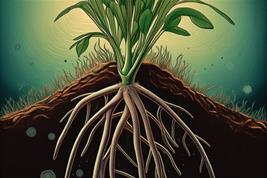21.08.2024

Researchers at the Leibniz-Centre for Agricultural Landscape Research (ZALF) have published an opinion paper in the journal "Plant and Soil" on the uptake of organic nitrogen (N) as an important nutrient source for plants in agricultural soils. In their paper, the researchers propose a combination of research methods that allows for a holistic view of the interactions between soil, plants and microorganisms and fills gaps in the knowledge of nitrogen uptake in research. In doing so, they provide the basis for developing new cropping practices that use nitrogen efficiently and are less dependent on chemical fertilizers.
The holistic concept presented in the paper emphasizes the importance of interactions between plant roots and microorganisms in the rhizosphere, the zone between the plant root and the soil. A wide variety of soil organisms are found here. Plants actively influence this zone by exuding substances through their roots. In doing so, they facilitate the uptake of nutrients needed for their growth. At the same time, they create better living conditions for other soil organisms.
Root exudates also promote the release of organically bound nitrogen, which is present in complex chemical compounds that cannot be absorbed by plant roots. However, how this organic nitrogen is made available to plants is not fully understood. Dr. Maire Holz of ZALF explains: "Our current knowledge of how plants use organic nitrogen is incomplete. Our new approach should help to fill these gaps”.
This approach encompasses several concepts designed to provide a new perspective on the field of research. For example, the researchers propose to apply the theory of root economy. This theory describes how plants develop different strategies to obtain nutrients from the soil. For example, they may develop fast, short-lived roots with high nutrient uptake, or denser roots that are less efficient but more durable.
The importance of nitrogen to agriculture and the environment
Nitrogen is an essential nutrient for plants. However, because organically bound nitrogen in the soil is not readily available to plants, it is applied to fields in the form of fertilizer. Although this nitrogen can be absorbed through the roots, only a portion of it reaches the plant. The rest escapes into the atmosphere as ammonia and nitrous oxide, or leaches into the soil as nitrate compounds. This increases the greenhouse effect, pollutes water and has a negative impact on biodiversity. Better use of organic nitrogen in the soil could reduce the need for fertilizers. The new approach provides a basis for future studies and the development of sustainable agricultural practices. "Our new approach provides a new understanding of how plants take up nitrogen. These findings could help reduce the use of chemical fertilizers and reduce environmental pollution," says Dr. Maire Holz.
Project partner:
- Institute of Soil Science, CEN Center for Earth System Research and Sustainability, Universität Hamburg, Hamburg, Germany – Dr. Joscha N. Becker
Funding:
Open Access funding enabled and organized by project DEAL. The authors declare that no funds, grants, or other support were received during the preparation of this manuscript.
Further Information:
Original Publication:
https://link.springer.com/article/10.1007/s11104-024-06839-9
Text disclaimer:
This is a summary of the original text created with the help of artificial intelligence: Holz, M., Lewin, S., Kolb, S., Becker, J. N., Bergmann, J. (2024) How to get to the N - a call for interdisciplinary research on organic N utilization pathways by plants. Plant and Soil.
https://doi.org/10.1007/s11104-024-06839-9, published Open Access/ published under the license CC BY 4.0
https://creativecommons.org/licenses/by/4.0/.
The text has been carefully reviewed and revised in the light of AI regulations at ZALF.
